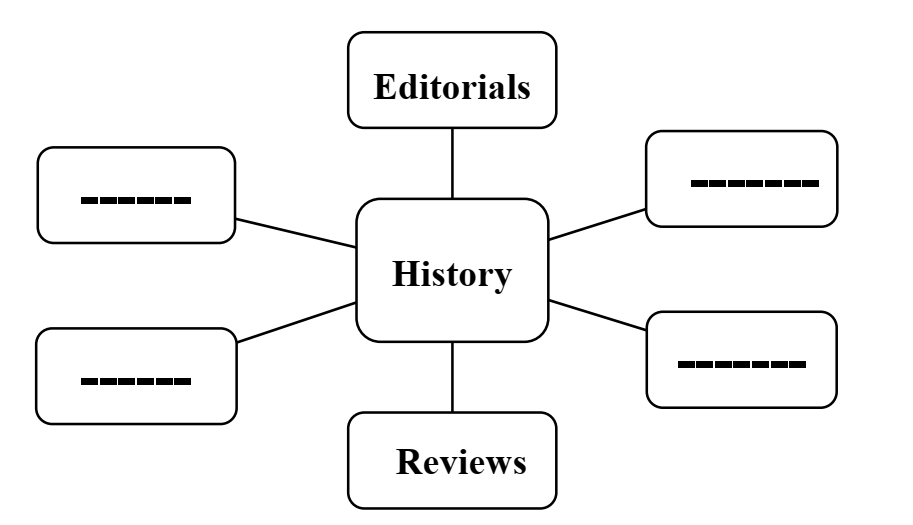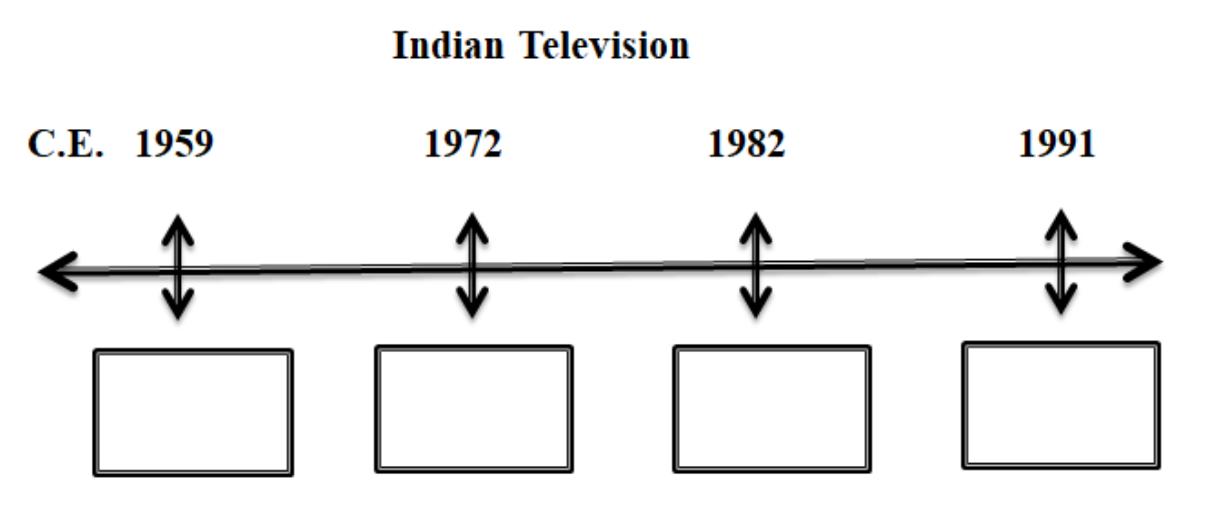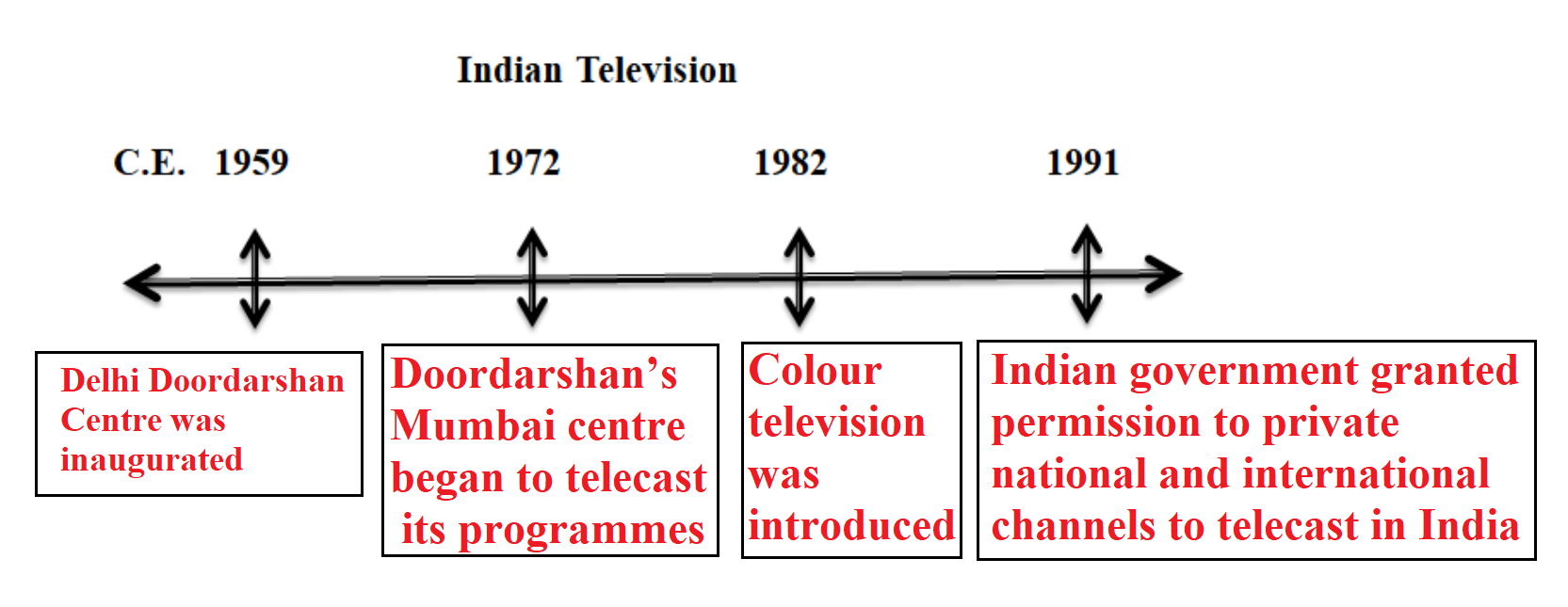Chapter 5. Mass Media and History
Q.l. (A) Choose the correct option from the given options and complete the sentences.
1. The first English newspaper in India was started by ……………
(A) James Augustus Hickey (B) John Marshall (C) Bhalshastri Jamabhekar (D) Allen Hume
2. Television is an …………… medium.
(A) visual (B) audio (C) audio-visual (D) print
3. Balshastri Jambhekar started the first magazine …………… in Marathi language.
(A) Darpan (B) Digdarshan (C) Pragati (D) Kesari
4. A newspaper representing the masses of the Indian society , was started by Krishnarao Bhalekar was ……………
(A) Deenbandhu (B) Dnyanoday (C) Kesari (D) Prabhakar
5. The …………… programmes are broadcasted in 24 regional languages as well as 146 dialects of Indian languages.
(A) Yuvawani (B) Vividh Bharati (C) Radio Mirchi (D) FM Redio
6. The honour of printing an illustration in an Indian newspaper for the first time, goes to ……………
(A) Darpan (B) Digdarshan (C) Pragati (D) Dnyanoday
(B) Identify the wrong pair in the following and rewrite.
(1)
i. ‘Prabhakar’ – Acharya P.K. Atre
ii. ‘Darpan’ – BalshastriJambhekar
iii. ‘Deenbandhu’ – KrishnaraoBhalekar
iv. ‘Kesari’ – BalGangadharTilak
Ans: Wrong pair: ‘Prabhakar’ – Acharya P. K. Atre
(2)
i. Kesari – daily
ii. Pragati – weekly
iii. Digdarshan – monthly magazine
iv. Bharatiya Itihas ani Samskruti – chronicle : no fixed time.
Ans: Wrong pair: Bharatiya Itihas ani Samskruti – chronicle : no fixed time
(3)
i. Rome – ActaDiurna
ii. Germany – Stern
iii. Bangladesh – Bengal Gazette
iv. India – Akashvani
Ans: Wrong pair: Bangladesh – Bengal Gazette
Q2. (A) Do as instructed.
1. Complete the following concept map.

Ans.

2. Complete the following concept map.
Ans.
3. Complete the following concept map.
Ans.
Q. 2. (B) Write short notes on.
1. The role of newspaper in the Indian struggle for independence.
Ans:
(1) In the pre-independence period, newspapers became the first mass medium of circulating information and knowledge among people.
(2) It brought about social and national awakening among the people and mobilised them against the oppressive British rule.
a. The newspaper Darpan made people aware of certain historical events like remarriage of Hindu widows, the danger of Russian attack on India, etc.
b. Dnyanoday shed light on the course of events which took place during the Indian War of Independence, 1857.
c. Deenbandhu discussed issues relating to the masses (Bahujan samaj) of that period.
d. Kesari and Mahratta newspapers threw light on the social and political issues of the contemporary period.
2. Why do we need mass media?
Ans:
(1) We need mass media to enable free flow of information to all strata of the society and to strengthen our democracy.
(2) Newspapers provide information about current events, on issues of social, political, economic, cultural and technological importance.
(3) It protects rights of people by creating awareness among them and thus protecting their freedom.
(4) Readers are also ensured of a platform to voice their opinions. Newspapers can help in making the democracy stronger.
(5) Television is an audio-visual medium. It shows actual visuals of an event to people, thus, crossing the inherent limitations of newspapers and radio.
(6) Radio broadcasts various entertainment, awareness creating and literary programmes.
3. Mass Media and professional opportunities.
Ans: Mass media is a field of mass communication. Newspaper, radio and television are some important forms of mass media. The professional opportunities in this field are us follows:
(1) Knowledge of history is sometimes essential for writing newspaper articles, planning radio programmes and telecasting historical shows and serials. For this people with deep knowledge of history are needed.
(2) Sometimes newspapers print columns under headings such as – ’50 years ago’ or ‘100 years ago’, etc. These columns help one in understanding the significant social, economic and political events that occurred in the past.
(3) For conducting discussions on various important occasions like the birth or death anniversaries of important national leaders, anniversaries of historical events, etc., historians are invited as experts by Akashvani.
(4) Television channels like Discovery, National Geographic, History, etc., take the help of historians while making the programmes.
(5) Moreover, people with deep knowledge of history are required while making television serials and movies. Their knowledge is required to achieve accuracy of stage backdrops for creating backdrop designs of atmosphere, costumes jewellery, make-up, hair styles, weaponory, lingual expression etc., suitable to the times of the theme of the movie.
4. Television
Ans:
(1) Nature:
a. Television is an audio-visual medium. It is also the most popular medium.
b. It telecasts news, mythological and historical serials, various competitions like singing, dancing, etc.
(2) History:
a. The ‘Delhi Doordarshan Centre’ was inaugurated by Dr. Rajendra Prasad, the first President of India.
b. On 1st May, 1972, Doordarshan’s Mumbai centre began to telecast its programmes.
c. On 15th August, 1982, colour television was introduced in India.
(3) Functions:
a. It overcomes the limitations of a radio & newspaper and shows the actual visuals of an event to people.
b. It provides entertainment and relaxation.
c. It enables people to view the historical, geographic and cultural wonders of the world by just sitting at home.
Q.3. Explain the following statements with its reason.
1. Any information received through mass media needs to be reviewed critically.
Ans:
(1) Mass media is a field of mass communication. It provides the various information.
(2) The news or information one receives through media might sometimes not represent the exact truth.
For example- ‘Stem’, a German weekly magazine, published the so-called handwritten diaries of Adolf Hitler in one of its edition. Later, the scientific examination of these diaries proved that it was forged.
Thus, it becomes clear that any information received through mass media needs to be reviewed critically.
2. Knowledge of history is essential for newspaper articles.
Ans:
(1) Newspapers provide current news to its readers.
(2) While reporting news in detail, sometimes, the reporters compare it with parallel events which happened in the past. These events are then printed in separate columns.
(3) The writer while writing these columns take help of historical documents or written history.
(4) In order to commemorate certain special occasions, newspapers publishes supplements or special issues to their regular edition.
Therefore, knowledge of history is essential for newspaper articles.
3. Television is the most popular medium.
Ans:
(1) Television is an audio-visual medium. It overcomes the limitations of a radio and newspaper and shows the actual visuals of an event, news, etc., whether national or international to people.
(2) Nowadays, television channels also telecast programmes based on history. For e.g. Channels like Discovery, History, National Geographic, etc.
(3) Various mythological and historical serials create interest in history among large number of people.
(4) These serials and programmes help people to have a deep understanding of the political, social, economic and cultural conditions of that particular period.
Due to all these reasons, television is the most popular medium.
4. Newspapers became the first mass medium of circulating information and knowledge among people.
Ans:
(1) In the olden days, a crier would run in the streets beating drums and crying out important news according to the orders of the king. Thus, the news spread among people by word of mouth and the information was communicated to far away destinations.
(2) After arrival of the British, printing technology and newspapers were introduced. So people started receiving printed news through newspapers.
Hence, newspapers became the first mass medium of circulating information and knowledge among people.
5. Newspapers, in those times were a very important medium of creating social awareness.
Ans:
(1) In the pre-independence period, newspapers became the first mass medium of circulating information and knowledge among people.
(2) It brought about social and national awakening among the people and mobilised them against the oppressive British rule.
a. The newspaper Darpan made people aware of certain historical events like remarriage of Hindu widows, the danger of Russian attack on India, etc.
b. Dnyanoday shed light on the course of events which took place during the Indian War of Independence, 1857.
c. Deenbandhu discussed issues relating to the masses (Bahujansamaj) of that period.
d. Kesari and Mahratta newspapers threw light on the social and political issues of the contemporary period.
Q.4. Read the following extract and answer the questions below.
Bharat EkKhoj
‘Bharat EkKhoj’, a serial telecasted by Doordarshan has a special place in the history of Indian television serials. It was based on ‘Discovery of India’, a book written by Pandit Jawaharlal Nehru. It was directed by ShyamBenegal. This serial presented the history of India from the ancient to the modern period, throwing light on social, cultural and political history of respective periods. It effectively portrayed many aspects of Indian history like Harappan Civilisation, Vedic history, interpretation of Ramayana and Mahabharata, Mauryan period, Turk-Afghan invasions, Mughal period and the contributions of Mughal emperors, Bhakti Movement, Role of Chhatrapati Shivaji Maharaj, movements of social reform and Indian
struggle for independence, etc. Roshan Seth, the actor who played Pandit Nehru’s role in this serial also appeared as a narrator, introducing and explaining various parts of the
story by dramatising them, using folklore and informative speeches. The serial was admired in all parts of India because of the comprehensive historical perspective of Pandit Nehru and its equally comprehensive visual presentation.
1. The serial Bharat Ek Khoj was based on which book?
Ans: The serial ‘Bharat Ek Khoj’ is based on a famous book titled ‘Discovery of India’ written by Pandit Jawaharlal Nehru.
2. Who played the role of Pandit Jawaharlal Nehru in Bharat Ek Khoj serial?
Ans: Roshan Seth, an actor played the role of Pandit Jawaharlal Nehru in Bharat Ek Khoj serial.
3. Why did Bharat Ek Khoj serial was admired in all parts of India?
Ans:
(1) This serial presented the history of india from the ancient to the modem period, throwing light on social, cultural and political history of the respective period.
(2) This serial portrays many aspects of Indian history like the Harappan civilisation, history of the Vedic period, interpretation of Ramayana and Mahabharata, Mauryan period, Turko-Afghan invasions, Mughal period and the contributions of the Mughal emperors, Bhakti Movement, role of Chhatrapati Shivaji Maharaj, social reform movements and India’s struggle for independence, etc.
Q.5. Answer the following questions in details.
1. How were news and messages conveyed to different countries in ancient times?
Ans:
(1) In olden days, the king would order a crier to run in the streets beating drums and crying out the important news to the people of his kingdom. Thus, the news would spread among people by word of mouth.
(2) In ancient Egypt, before the beginning of Common Era, there was a custom of placing inscriptions containing royal decrees at public places. In India, Emperor Ashoka also used the similar method to convey his orders to the subjects.
(3) In the Roman Empire, royal decrees and the information of various events taking place in the nation and its capital were written on papers and then distributed in all regions.
(4) In Rome, during the reign of Julius Caesar, newspaper known as ‘Acta Diurna (Daily Events or Daily Public Records) was placed at public places to convey the royal commands to people.
(5) In the 7th century C.E., royal dictates were distributed among people at public places.
(6) In England, handouts giving information about wars or important events were distributed occasionally among people.
(7) Travellers arriving from faraway places, during their stay at rest houses, would spice up the stories of those places and then narrate it to the local people.
(8) There were some kings who posted their ambassadors at various places. These ambassadors conveyed important news of their region to the royal court.
In this way, before the publication of newspapers, the royal decrees or important news were made known to people either through a crier, through inscriptions, through handouts or through ambassadors.
2. Explain the contribution of Balshastri Jambhekar in Marathi Journalism?
Ans:
(1) Balshastri Jambhekar worked in the field of print news.
(2) He is referred to as the ‘First Editor’ by virtue of his being the editor of the first Marathi newspaper. He started the newspaper ‘Darpan’ in 1832 in Mumbai.
(3) The news printed in Darpan can be reviewed to know about the political, economical, social and cultural events of those times which are important in Historiography.
(4) 6th January, the birth date of Balshastri Jambhekar, who was the editor of first marathi newspaper ‘Darpan’, is observed in Maharashtra as the Journalists’ Day.
3. Why do we need Mass Media?
Ans:
(1) We need mass media to enable free flow of information to all strata of the society and to strengthen our democracy.
(2) Newspapers provide information about current events, on issues of social, political, economic, cultural and technological importance.
(3) It protects rights of people by creating awareness among them and thus protecting their freedom.
(4) Readers are also ensured of a platform to voice their opinions. Newspapers can help in making the democracy stronger.
(5) Television is an audio-visual medium. It shows actual visuals of an event to people, thus, crossing the inherent limitations of newspapers and radio.
(6) Radio broadcasts various entertainment, awareness creating and literary programmes.
4. How does History is essential in planning radio programmes?
Ans: History is essential in planning radio programmes in the following ways:
(1) The speeches delivered every year by the Prime Ministers of India on 15 August are recorded and preserved by Akashvani. These recordings are then broadcasted on certain important occasions.
(2) For conducting discussions on various important occasions like the birth or death anniversaries of important national leaders, anniversaries of historical events, etc., historians are invited as experts by Akashvani.
(3) To conduct daily programmes like ‘On this day in History’ and to give lectures on the work done by various national leaders, knowledge of history is essential.